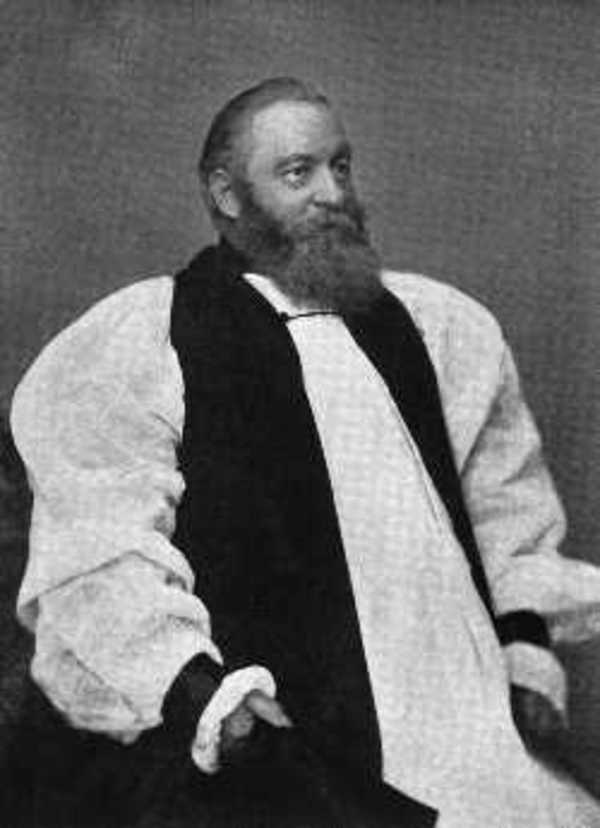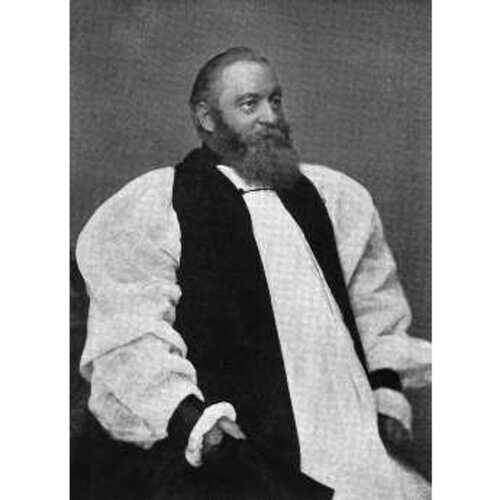
Source: Courtesy of Wikimedia Commons
HORDEN, JOHN, Church of England clergyman, bishop, translator, and author; b. 20 Jan. 1828 in Exeter, England, eldest son of William Horden, a printer, and Sarah Seward; m. 28 May 1851 Elizabeth Oke, and they had two sons and four daughters; d. 12 Jan. 1893 in Moose Factory (Ont.).
John Horden was educated in Exeter at St John’s Hospital, a charitable institution. Apprenticed at an early age to a blacksmith, he taught Sunday school at St Thomas the Apostle Church, where he was strongly influenced by the Reverend John Medley. In 1851 Horden became a teacher at a boys’ school and offered himself to the Church Missionary Society, hoping for a posting to India. Instead, in May he accepted at short notice the position of teacher and catechist at the Hudson’s Bay Company post of Moose Factory. The first permanent mission there had been established in 1840 by the Reverend George Barnley of the Wesleyan Methodist Missionary Society. Barnley abandoned the mission in 1847 following conflicts with the chief factor, Robert Seaborn Miles, and, since the WMMS proved unable to replace him, in 1851 the HBC offered the mission to the CMS, deliberately ignoring an overture from the Oblates of Mary Immaculate.
Horden and his wife arrived at Moose Factory on the HBC supply ship Prince Albert on 26 Aug. 1851. Bishop David Anderson* of Rupert’s Land intended to keep Horden at Moose for a year and then bring him to the Red River settlement (Man.) for theological training. However, Anderson learned from the CMS that Horden’s letters to it displayed “much maturity of judgment, Christian principle, and activity of mind” and were more informative than those usually received from the mission field. Moreover, when he visited Moose in 1852 he observed Horden’s “great competence and fluency” in the Cree language and his rapport with the Indians. He therefore changed his plans and ordained Horden priest on 24 August.
Another reason for Horden’s progress was his diplomacy in dealing with the HBC. Although believing strongly that “if the Sabbath is neglected, everything else holy and good is neglected too,” he was willing to compromise on Sunday travel and hunting because he recognized that local conditions made strict observation difficult. Horden used every effort to communicate with the inhabitants of his mission. A gifted linguist, he was not only fluent in Cree but also acquired a working knowledge of Ojibwa, Inuktitut, Chipewyan, and Norwegian – the last because the HBC had several Norwegian employees at Moose in the 1850s. Horden and native associates translated numerous religious works into the syllabic system of writing invented by James Evans*, to which the James Bay Cree had been introduced in the early 1840s. He and some young native trainees also operated a small printing-press from 1853 to 1859, when the CMS took responsibility for publications. Horden’s major linguistic contribution was to be A grammar of the Cree language, as spoken by the Cree Indians of North America (London, 1881).
One year after Horden arrived he began a series of visits to posts in the James Bay region, starting with Martin Falls (Ont.) and continuing in 1853 with Rupert’s House (Waskaganish, Que.). In 1852 the Reverend Edwin Arthur Watkins was sent to Fort George (Que.) to begin work on eastern James Bay, and over the next decade more missionaries were sent out. They were seen as temporary appointments, for the CMS planned to have a church staffed by native clergymen. Horden’s first native assistant was John Smith, an Indian who had briefly served Barnley. However, in 1854 he was dismissed for drunkenness and sexual misconduct. John Turner, a young man of native and European ancestry, helped Horden for a short time, but in 1854 he was transferred by the HBC to Little Whale River (Petite Rivière de la Baleine, Que.). Thomas Vincent*, another man of mixed ancestry, arrived at Moose in 1855 to act as schoolteacher and receive theological training. Ordained in 1860, he was sent that year to Fort Albany (Ont.) to establish a permanent mission and counteract the influence of Roman Catholic priests.
By 1872 Bishop Robert Machray* of Rupert’s Land had decided that his diocese was too large to supervise adequately, and in that year three new dioceses were created from it. Horden was consecrated in Westminster Abbey on 15 December as the first bishop of Moosonee, a diocese containing much of the drainage basins of Hudson and James bays. He continued to travel the length and breadth of the region, going to Missanabie (Ont.) in 1875, York Factory (Man.) four years later, and Fort Churchill (near Churchill, Man.) in 1889. By the end of his career CMS missionaries and agents had converted or reconverted virtually all the Cree of eastern James Bay, Moose Factory, Fort Churchill, and York Factory, as well as many Ojibwa, Chipewyan, and Inuit. In 1892, however, a year-round Catholic mission was established at Fort Albany, and denominational competition in western James Bay became much more fierce.
Although Horden was in agreement with CMS policy about the formation of a church staffed by natives, he was a gradualist; even in 1893 there were more English than native missionaries in the diocese. His attitude towards a successor best illustrates his feelings. Vincent was the logical choice because of his 38 years of experience and his fluency in English and Cree, but Horden considered him unfit because of his mixed ancestry and consequent lack of influence among the Europeans in the diocese. Moreover, Vincent had no important connections in England, where the diocese had constantly to appeal for funds. When Horden died unexpectedly in 1893, therefore, Jervois Arthur Newnham became bishop. Horden is buried in the HBC graveyard at Moose Factory beside his infant daughter, Ellen Hudson.
John Horden’s accomplishments during his 42-year career are impressive; few made more of a commitment or had a more lasting influence. However, his impact on native people has only now begun to be reassessed. Some clergymen of mixed ancestry had been trained, but they had been denied high office. He had encouraged the Indians to abandon their traditional beliefs and practices, not ascribing to them any spiritual or cultural value. The Anglican faith has become an adopted tradition for many of their descendants, although CMS plans for financial independence and local leadership have largely failed to materialize. Some native people feel that Anglicans are not “real” Christians and have embraced fundamentalist teachings. Others, offended by the churches’ cultural arrogance, are searching for native religious values and practices, whether rooted in their own cultural traditions or, more often, adopted from pan-Indianism developed elsewhere in North America. A few hope to synthesize their Anglican faith with rediscovered native traditions.
ACC, General Synod Arch. (Toronto), M 61-3 (Moosonee coll.), Horden letter-books. Univ. of Birmingham Library, Special Coll. (Birmingham, Eng.), Church Missionary Soc. Arch., records. Beatrice Batty, Forty-two years amongst the Indians and Eskimo; pictures from the life of the Right Reverend John Horden, first bishop of Moosonee (London, 1893). T. C. B. Boon, The Anglican Church from the Bay to the Rockies: a history of the ecclesiastical province of Rupert’s Land and its dioceses from 1820 to 1950 (Toronto, 1962). J. S. Long, “‘Shaganash’: early Protestant missionaries and the adoption of Christianity by western James Bay Cree, 1840–1893” (ed.d. thesis, Univ. of Toronto, 1986). J. M. Banks, “The Church Missionary Society press at Moose Factory: 1853–1859,” Canadian Church Hist. Soc., Journal (Toronto), 26 (1984), 69–80. J. S. Long, “Archdeacon Thomas Vincent of Moosonee and the handicap of ‘Metis’ racial status,” Canadian Journal of Native Studies (Brandon, Man.), 3 (1983): 95–116; “The Cree prophets: oral and documentary accounts,” Canadian Church Hist. Soc., Journal, 31 (1989): 3–13; “Education in the James Bay region during the Horden years,” OH, 70 (1978): 75–89; “John Horden, first bishop of Moosonee: diplomat and man of compromise,” Canadian Church Hist. Soc., Journal, 27 (1985): 86–97; and “Manitu, power, books and wiihtikow: some factors in the adoption of Christianity by nineteenth-century western James Bay Cree,” Native Studies Rev. (Saskatoon), 3 (1987), no.1: 1–30.
Cite This Article
John S. Long, “HORDEN, JOHN,” in Dictionary of Canadian Biography, vol. 12, University of Toronto/Université Laval, 2003–, accessed January 1, 2026, https://www.biographi.ca/en/bio/horden_john_12E.html.
The citation above shows the format for footnotes and endnotes according to the Chicago manual of style (16th edition). Information to be used in other citation formats:
| Permalink: | https://www.biographi.ca/en/bio/horden_john_12E.html |
| Author of Article: | John S. Long |
| Title of Article: | HORDEN, JOHN |
| Publication Name: | Dictionary of Canadian Biography, vol. 12 |
| Publisher: | University of Toronto/Université Laval |
| Year of publication: | 1990 |
| Year of revision: | 1990 |
| Access Date: | January 1, 2026 |



